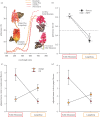Flower colour adaptation in a mimetic orchid
- PMID: 22298842
- PMCID: PMC3350669
- DOI: 10.1098/rspb.2011.2375
Flower colour adaptation in a mimetic orchid
Abstract
Although the tremendous variability in floral colour among angiosperms is often attributed to divergent selection by pollinators, it is usually difficult to preclude the possibility that floral colour shifts were driven by non-pollinator processes. Here, we examine the adaptive significance of flower colour in Disa ferruginea, a non-rewarding orchid that is thought to attract its butterfly pollinator by mimicking the flowers of sympatric nectar-producing species. Disa ferruginea has red flowers in the western part of its range and orange flowers in the eastern part--a colour shift that we hypothesized to be the outcome of selection for resemblance to different local nectar-producing plants. Using reciprocal translocations of red and orange phenotypes as well as arrays of artificial flowers, we found that the butterfly Aeropetes tulbaghia, the only pollinator of the orchid, preferred both the red phenotype and red artificial flowers in the west where its main nectar plant also has red flowers, and both the orange phenotype and orange artificial flowers in the east, where its main nectar plant has orange flowers. This phenotype by environment interaction demonstrates that the flower colour shift in D. ferruginea is adaptive and driven by local colour preference in its pollinator.
Figures


References
-
- Ashman T. L., Majetic C. J. 2006. Genetic constraints on floral evolution: a review and evaluation of patterns. Heredity 96, 343–35210.1038/sj.hdy.6800815 (doi:10.1038/sj.hdy.6800815) - DOI - DOI - PubMed
-
- Harder L. D., Johnson S. D. 2009. Darwin's beautiful contrivances: evolutionary and functional evidence for floral adaptation. New Phytol. 183, 530–54510.1111/j.1469-8137.2009.02914.x. (doi:10.1111/j.1469-8137.2009.02914.x.) - DOI - DOI - PubMed
-
- Johnson S. D., Harder L. D., Barrett S. C. H. 2006. Pollinator-driven speciation in plants. In The ecology and evolution of flowers (eds Harder L. D., Barret S. C. H.), pp. 295–310 Oxford, UK: Oxford University Press
-
- Kay K. M., Sargent R. D. 2009. The role of animal pollination in plant speciation: integrating ecology, geography, and genetics. Annu. Rev. Ecol. Syst. 40, 637–65610.1146/annurev.ecolsys.110308.120310 (doi:10.1146/annurev.ecolsys.110308.120310) - DOI - DOI
-
- Galen C. 1999. Why do flowers vary? The functional ecology of variation in flower size and form within natural plant populations. Bioscience 49, 631–64010.2307/1313439 (doi:10.2307/1313439) - DOI - DOI
Publication types
MeSH terms
LinkOut - more resources
Full Text Sources

